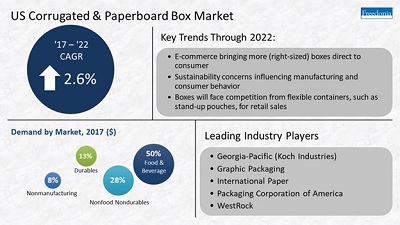Demand for folding paperboard boxes is expected to grow 3.9% per year through 2022 to $12.8 billion.
Demand for all types of corrugated and paperboard boxes (i.e., corrugated and solid fiber, folding paperboard and set-up paperboard) is forecast to increase 2.6% annually to $42.5 billion in 2022. Nearly half of all new demand will stem from the large food and beverage market, and 16% of new box sales will derive from the small but rapidly growing e-commerce segment.
These and other trends are presented in Corrugated & Paperboard Boxes, a new study from The Freedonia Group, a Cleveland-based industry research firm.
In 2018, the Trump administration levied a 10% tariff on folding cartons from China that was scheduled to increase to 25% on January 1, 2019. However, in December 2018, China and the United States agreed on a temporary suspension of tariff increases. If tariffs continue to rise as planned, Freedonia research suggests they will result in increases in domestic production as well as a more rapid transition to flexible packaging formats.
The U.S. maintains a trade deficit in folding paperboard boxes that accounted for about 5% of demand in 2017:
● By value, Canada supplies almost half of the folding cartons imported to the US due to its geographic proximity and abundant forestry resources and processing facilities.
● China is the second largest source of folding cartons – in both volume and value terms – because the country’s low manufacturing costs offset the cost of shipping these products.
Click here for more information.
Article topics









